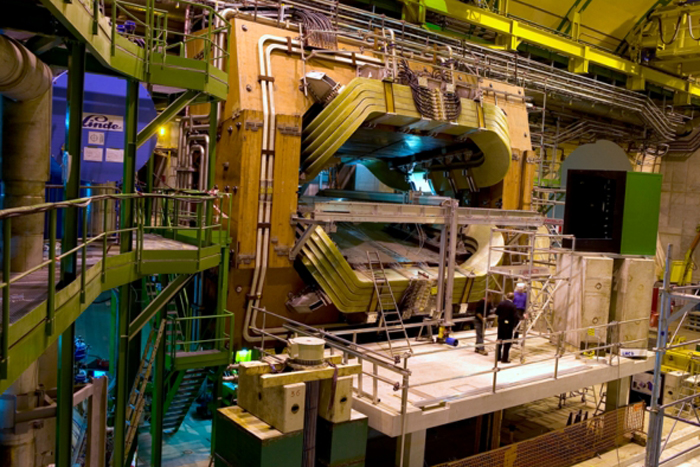'Charming' Heavy Particle Discovered at World's Largest Atom Smasher

The world's largest atom smasher has revealed a new kind of particle, and so far, it leads a charmed existence.
The discovery of the particle, which is made up of two so-called charm quarks, validates the predictions of the Standard Model, the current reigning model of particle physics.
The new particle was discovered at the Large Hadron Collider (LHC), a 16-mile-long (27 kilometers) underground ring near Geneva, Switzerland, where protons zoom at near light-speed before smashing into each other. As the protons disintegrated in a recent experiment, the new particle, called the Xi-cc-plus-plus (the "Xi" is pronounced "ksi"), emerged. [Photos: The World's Largest Atom Smasher]
New member of the particle zoo
The Xi joins a menagerie of other particles that form the world of the very small. The Xi is a baryon, which means a particle made of three even smaller particles called quarks. The most famous baryons are protons and neutrons, which make up everyday matter. Quarks, meanwhile, come in six varieties (called "flavors"), and by mixing and matching different flavors and numbers of quarks, nature produces baryons with different masses and charges. The quark flavors are: up, down, top, bottom, charm and strange.
The newly discovered Xi particle is a heavyweight. Consisting of two charm quarks and an up quark, it weighs in at 3,621 million electron volts (MeV), according to a statement from CERN, the European Organization for Nuclear Research, which runs the LHC. For comparison, a proton, which is made of two up quarks and a down quark, weighs in at 938 MeV. (Because mass can be translated into energy using Albert Einstein's E=mc^2, particle masses are measured in electron volts, which is how much energy their mass represents.)
The new, exotic particle wasn't seen directly at the LHC, because it lasts for only a tiny fraction of a second. In this instance, researchers identified the Xi-cc by its decay products. The Xi decays into a particle called the lambda baryon and three lighter particles, the K- (or kaon) and two pions. [Infographic: Nature's Tiniest Particles Dissected]
Long-sought particle finally found
Physicists previously predicted the existence of the Xi-cc, but it wasn't clear what the mass of the particle would be; nobody knew if the theoretical predictions were correct.
Sign up for the Live Science daily newsletter now
Get the world’s most fascinating discoveries delivered straight to your inbox.
As it happened, the theories were right — the mass was what it was supposed to be. "If there were anomalies, uncharted interactions among the quarks, they might show up as the masses being off from predictions," said Jonathan Rosner, an emeritus professor of physics at the University of Chicago who outlined a theoretical mass for the Xi in 2014.
The mass of the Xi turned out to be about 3,621 MeV. Rosner's study got a figure that was quite close: 3,627 MeV.
An earlier experiment at Fermilab, called the Segmented Large X Baryon Spectrometer (SELEX), had appeared to find the Xi in 2002, but Rosner noted that the mass estimate seemed too low.
"They got a mass 100 MeV lower than reasonable predictions," Rosner told Live Science.
Had the LHC found such a low mass, it would have shown that there was something wrong in the Standard Model, Rosner said. But that didn't happen; the Xi behaved as Rosner predicted, and the Standard Model has survived yet another experiment.
Charmed existence
The discovery also proved baryons with two heavy quarks actually exist, something physicists couldn't say for sure until now even though the theories all said they should, according to CERN. Previous experiments had produced many particles with one heavy quark, but never two. Baryons like the Xi that have two charm quarks are called "doubly charmed."
Another weird thing about the Xi, compared to its more ordinary cousins, is that the massive charm quarks leave the lightweight up quark "orbiting" its heavier cousins. (Strictly speaking this isn't quite how things work, because quarks are quantum mechanical objects, so they don't have positions like bowling balls do, but rather behave more like waves). In a proton, the quark masses are more similar, so they move around each other in a different way.
"In contrast to other baryons, in which the three quarks perform an elaborate dance around each other, a doubly heavy baryon is expected to act like a planetary system, where the two heavy quarks play the role of heavy stars orbiting one around the other, with the lighter quark orbiting around this binary system," Guy Wilkinson, former spokesperson for an LHC experiment called LHCb, said in a statement.
The findings could bring new insights about the strong interaction, the force that binds particles together, researchers said.
"Finding a doubly-heavy-quark baryon is of great interest as it will provide a unique tool to further probe quantum chromodynamics, the theory that describes the strong interaction, one of the four fundamental forces," Giovanni Passaleva, spokesperson for the LHCb collaboration, said in a statement. "Such particles will thus help us improve the predictive power of our theories."
The study outlining the results has been submitted to the journal Physical Review Letters.
Originally published on Live Science.










